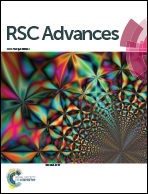Pyridine-based poly(aryleneethynylene)s: a study on anionic side chain density and their influence on optical properties and metallochromicity†
Abstract
We report the Pd-catalyzed synthesis of six new water soluble, alternating poly(p-phenyleneethynylene-p-pyridinyleneethynylene) (abcb-alternating) copolymers and one poly(p-pyridinyleneethynylene). These poly(aryleneethynylene)s (PAEs) have a degree of polymerization Pn of 10 to 16 repeat units, with polydispersities ranging from Mn/Mw = 1.2–2.6. The attachment of two to six carboxylate groups per repeat unit renders the PAEs watersoluble. Six of the seven PAEs share the exact same backbone structure; they are only distinguished by an increasing number of solubilizing carboxylate groups. Optical properties, emissive lifetimes and quantum yields are reported, revealing the influence of anionic side chain density and distribution on the fluorophore. Protons and metal cations affect the optical properties of these PAEs. The emission of aqueous solutions of these PAEs is quenched upon acidification and by both mercury and lead salts. Log KSV values of up to 5.0 for mercury ions and 5.4 for lead ions are reported.


 Please wait while we load your content...
Please wait while we load your content...